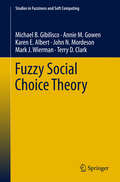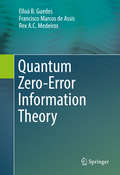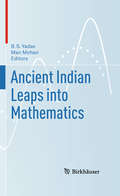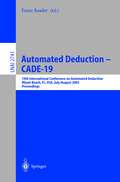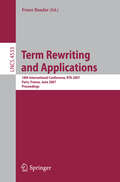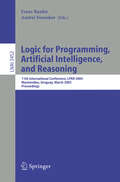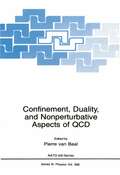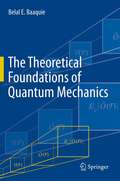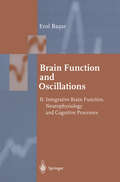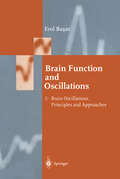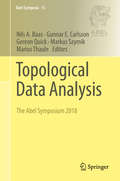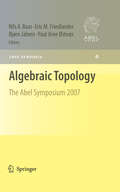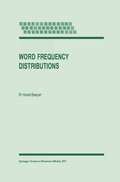- Table View
- List View
Fuzzy Social Choice Theory (Studies in Fuzziness and Soft Computing #315)
by Michael B. Gibilisco Annie M. Gowen Karen E. Albert John N. Mordeson Mark J. Wierman Terry D. ClarkThis book offers a comprehensive analysis of the social choice literature and shows, by applying fuzzy sets, how the use of fuzzy preferences, rather than that of strict ones, may affect the social choice theorems. To do this, the book explores the presupposition of rationality within the fuzzy framework and shows that the two conditions for rationality, completeness and transitivity, do exist with fuzzy preferences. Specifically, this book examines: the conditions under which a maximal set exists; the Arrow’s theorem; the Gibbard-Satterthwaite theorem and the median voter theorem. After showing that a non-empty maximal set does exists for fuzzy preference relations, this book goes on to demonstrating the existence of a fuzzy aggregation rule satisfying all five Arrowian conditions, including non-dictatorship. While the Gibbard-Satterthwaite theorem only considers individual fuzzy preferences, this work shows that both individuals and groups can choose alternatives to various degrees, resulting in a social choice that can be both strategy-proof and non-dictatorial. Moreover, the median voter theorem is shown to hold under strict fuzzy preferences but not under weak fuzzy preferences. By providing a standard model of fuzzy social choice and by drawing the necessary connections between the major theorems, this book fills an important gap in the current literature and encourages future empirical research in the field.
Quantum Zero-Error Information Theory
by Elloá B. Guedes Francisco Marcos de Assis Rex A. MedeirosThis book aims at presenting the field of Quantum Information Theory in an intuitive, didactic and self-contained way, taking into account several multidisciplinary aspects. Therefore, this books is particularly suited to students and researchers willing to grasp fundamental concepts in Quantum Computation and Quantum Information areas.The field of Quantum Information Theory has increased significantly over the last three decades. Many results from classical information theory were translated and extended to a scenario where quantum effects become important. Most of the results in this area allows for an asymptotically small probability of error to represent and transmit information efficiently. Claude E.Shannon was the first scientist to realize that error-free classical information transmission can be accomplished under certain conditions. More recently, the concept of error-free classical communication was translated to the quantum context. The so-called Quantum Zero-Error Information Theory completes and extends the Shannon Zero-Error Information Theory.
Ancient Indian Leaps into Mathematics
by B. S. Yadav and Man MohanB.S. Yadav and Man MohanThis book presents contributions of mathematicians covering topics from ancient India, placing them in the broader context of the history of mathematics. Although the translations of some Sanskrit mathematical texts are available in the literature, Indian contributions are rarely presented in major Western historical works. Yet some of the well-known and universally-accepted discoveries from India, including the concept of zero and the decimal representation of numbers, have made lasting contributions to the foundation of modern mathematics. Through a systematic approach, this book examines these ancient mathematical ideas that were spread throughout India, China, the Islamic world, and Western Europe.
Magic and Antimagic Graphs: Attributes, Observations and Challenges in Graph Labelings (Developments in Mathematics #60)
by Martin Bača Mirka Miller Joe Ryan Andrea Semaničová-FeňovčíkováMagic and antimagic labelings are among the oldest labeling schemes in graph theory. This book takes readers on a journey through these labelings, from early beginnings with magic squares up to the latest results and beyond.Starting from the very basics, the book offers a detailed account of all magic and antimagic type labelings of undirected graphs. Long-standing problems are surveyed and presented along with recent results in classical labelings. In addition, the book covers an assortment of variations on the labeling theme, all in one self-contained monograph.Assuming only basic familiarity with graphs, this book, complete with carefully written proofs of most results, is an ideal introduction to graph labeling for students learning the subject. More than 150 open problems and conjectures make it an invaluable guide for postgraduate and early career researchers, as well as an excellent reference for established graph theorists.
Automated Deduction - CADE-19: 19th International Conference on Automated Deduction Miami Beach, FL, USA, July 28 - August 2, 2003, Proceedings (Lecture Notes in Computer Science #2741)
by Franz BaaderThe refereed proceedings of the 19th International Conference on Automated Deduction, CADE 2003, held in Miami Beach, FL, USA in July 2003. The 29 revised full papers and 7 system description papers presented together with an invited paper and 3 abstracts of invited talks were carefully reviewed and selected from 83 submissions. All current aspects of automated deduction are discussed, ranging from theoretical and methodological issues to the presentation of new theorem provers and systems.
Term Rewriting and Applications: 18th International Conference, RTA 2007, Paris, France, June 26-28, 2007, Proceedings (Lecture Notes in Computer Science #4533)
by Franz BaaderThe 18th International Conference on Rewriting Techniques and Applications, held in Paris, France in June 2007, featured presentations and discussions centering on some of the latest advances in the field. This volume presents the proceedings from that meeting. Papers cover current research on all aspects of rewriting, including applications, foundational issues, frameworks, implementations, and semantics.
Logic for Programming, Artificial Intelligence, and Reasoning: 11th International Workshop, LPAR 2004, Montevideo, Uruguay, March 14-18, 2005, Proceedings (Lecture Notes in Computer Science #3452)
by Franz Baader Andrei VoronkovConfinement, Duality, and Nonperturbative Aspects of QCD (Nato Science Series B: #368)
by Pierre Van BaalProceedings of a NATO ASI and Isaac Newton Institute Workshop held in Cambridge, UK, June 23-July 4, 1997
The Theoretical Foundations of Quantum Mechanics
by Belal E. BaaquieThe Theoretical Foundations of Quantum Mechanics addresses fundamental issues that are not discussed in most books on quantum mechanics. This book focuses on analyzing the underlying principles of quantum mechanics and explaining the conceptual and theoretical underpinning of quantum mechanics. In particular, the concepts of quantum indeterminacy, quantum measurement and quantum superposition are analyzed to clarify the concepts that are implicit in the formulation of quantum mechanics.The Schrodinger equation is never solved in the book. Rather, the discussion on the fundamentals of quantum mechanics is treated in a rigorous manner based on the mathematics of quantum mechanics. The new concept of the interplay of empirical and trans-empirical constructs in quantum mechanics is introduced to clarify the foundations of quantum mechanics and to explain the counter-intuitive construction of nature in quantum mechanics.The Theoretical Foundations of Quantum Mechanics is aimed at the advanced undergraduate and assumes introductory knowledge of quantum mechanics. Its objective is to provide a solid foundation for the reader to reach a deeper understanding of the principles of quantum mechanics.
Mathematical Methods and Quantum Mathematics for Economics and Finance
by Belal Ehsan BaaquieGiven the rapid pace of development in economics and finance, a concise and up-to-date introduction to mathematical methods has become a prerequisite for all graduate students, even those not specializing in quantitative finance. This book offers an introductory text on mathematical methods for graduate students of economics and finance–and leading to the more advanced subject of quantum mathematics. The content is divided into five major sections: mathematical methods are covered in the first four sections, and can be taught in one semester. The book begins by focusing on the core subjects of linear algebra and calculus, before moving on to the more advanced topics of probability theory and stochastic calculus. Detailed derivations of the Black-Scholes and Merton equations are provided – in order to clarify the mathematical underpinnings of stochastic calculus. Each chapter of the first four sections includes a problem set, chiefly drawn from economics and finance. In turn, section five addresses quantum mathematics. The mathematical topics covered in the first four sections are sufficient for the study of quantum mathematics; Black-Scholes option theory and Merton’s theory of corporate debt are among topics analyzed using quantum mathematics.
Brain Function and Oscillations: Volume II: Integrative Brain Function. Neurophysiology and Cognitive Processes (Springer Series in Synergetics)
by Erol BaşarNeuroscience is ripe for a paradigm change as Freeman and Mountcastle describe. Brain Oscillations provide an important key to this change. In this book the functional importance of the brain's multiple oscillations is treated with an integrative scope. According to the author, neurophysiology and cognition demand integrative approaches similar to those of Galilei and Newton in physics and of Darwin in biology. Not only the human brain but also lower brains and ganglia of invertebrates are treated with electrophysical methods. Experiments on sensory registration, perception, movement, and cognitive processes related to attention, learning, and memory are described. A synopsis on brain functions leads to a new neuron assemblies doctrine, extending the concept of Sherrington, and new trends in this field. The book will appeal to scientists and graduate students.
Brain Function and Oscillations: Volume I: Brain Oscillations. Principles and Approaches (Springer Series in Synergetics)
by Erol Başarby W. J. Freeman These two volumes on "Brain Oscillations" appear at a most opportune time. As the "Decade of the Brain" draws to its close, brain science is coming to terms with its ultimate problem: understanding the mechanisms by which the immense number of neurons in the human brain interact to produce the higher cognitive functions. The ideas, concepts, methods, interpretations and examples, which are presented here in voluminous detail by a world-class authority in electrophysiology, summarize the intellectual equipment that will be required to construct satisfactory solutions to the problem. Neuroscience is ripe for change. The last revolution of ideas took place in the middle of the century now ending, when the field took a sharp turn into a novel direction. During the preceding five decades the prevailing view, carried forward from the 19th century, was that neurons are the carriers of nerve energy, either in chemical or electrical forms (Freeman, 1995). That point of view was enormously productive in terms of coming to understand the chemical basis for synaptic transmission, the electrochemistry of the ac tion potential, the ionic mechanisms of membrane currents and gates, the functional neuroanatomy that underlies the hierarchy of reflexes, and the neural fields and'their resonances that support Gestalt phenomena. No bet ter testimony can be given of the power of the applications of this approach than to point out that it provides the scientific basis for contemporary neu rology, neuropsychiatry, and brain imaging.
Summability Theory and Its Applications
by Feyzi BaşarSummability Theory and Its Applications explains various aspects of summability and demonstrates its applications in a rigorous and coherent manner. The content can readily serve as a reference or as a useful series of lecture notes on the subject. This substantially revised new edition includes brand new material across several chapters as well as several corrections, including: the addition of the domain of Cesaro matrix C(m) of order m in the classical sequence spaces to Chapter 4; and introducing the domain of four-dimensional binomial matrix in the spaces of bounded, convergent in the Pringsheim's sense, both convergent in the Pringsheim's sense and bounded, and regularly convergent double sequences, in Chapter 7. Features Investigates different types of summable spaces and computes their dual Suitable for graduate students and researchers with a (special) interest in spaces of single and double sequences, matrix transformations and domains of triangle matrices Can serve as a reference or as supplementary reading in a computational physics course, or as a key text for special Analysis seminars.
Summability Theory and Its Applications: Topics In Modern Summability Theory (Mathematics And Its Applications Ser.)
by Feyzi BaşarSummability Theory and Its Applications explains various aspects of summability and demonstrates its applications in a rigorous and coherent manner. The content can readily serve as a reference or as a useful series of lecture notes on the subject. This substantially revised new edition includes brand new material across several chapters as well as several corrections, including: the addition of the domain of Cesaro matrix C(m) of order m in the classical sequence spaces to Chapter 4; and introducing the domain of four-dimensional binomial matrix in the spaces of bounded, convergent in the Pringsheim's sense, both convergent in the Pringsheim's sense and bounded, and regularly convergent double sequences, in Chapter 7. Features Investigates different types of summable spaces and computes their dual Suitable for graduate students and researchers with a (special) interest in spaces of single and double sequences, matrix transformations and domains of triangle matrices Can serve as a reference or as supplementary reading in a computational physics course, or as a key text for special Analysis seminars.
Summable Spaces and Their Duals, Matrix Transformations and Geometric Properties (Chapman & Hall/CRC Monographs and Research Notes in Mathematics)
by Feyzi Başar Hemen DuttaThe aim of Summable Spaces and Their Duals, Matrix Transformations and Geometric Properties is to discuss primarily about different kinds of summable spaces, compute their duals and then characterize several matrix classes transforming one summable space into other. The book also discusses several geometric properties of summable spaces, as well as dealing with the construction of summable spaces using Orlicz functions, and explores several structural properties of such spaces. Each chapter contains a conclusion section highlighting the importance of results, and points the reader in the direction of possible new ideas for further study. Features Suitable for graduate schools, graduate students, researchers and faculty, and could be used as a key text for special Analysis seminars Investigates different types of summable spaces and computes their duals Characterizes several matrix classes transforming one summable space into other Discusses several geometric properties of summable spaces Examines several possible generalizations of Orlicz sequence spaces
Summable Spaces and Their Duals, Matrix Transformations and Geometric Properties (Chapman & Hall/CRC Monographs and Research Notes in Mathematics)
by Feyzi Başar Hemen DuttaThe aim of Summable Spaces and Their Duals, Matrix Transformations and Geometric Properties is to discuss primarily about different kinds of summable spaces, compute their duals and then characterize several matrix classes transforming one summable space into other. The book also discusses several geometric properties of summable spaces, as well as dealing with the construction of summable spaces using Orlicz functions, and explores several structural properties of such spaces. Each chapter contains a conclusion section highlighting the importance of results, and points the reader in the direction of possible new ideas for further study. Features Suitable for graduate schools, graduate students, researchers and faculty, and could be used as a key text for special Analysis seminars Investigates different types of summable spaces and computes their duals Characterizes several matrix classes transforming one summable space into other Discusses several geometric properties of summable spaces Examines several possible generalizations of Orlicz sequence spaces
Double Sequence Spaces and Four-Dimensional Matrices (Chapman & Hall/CRC Monographs and Research Notes in Mathematics)
by Feyzi Başar Medine Yeşilkayagil SavaşcıDouble Sequence Spaces and Four-Dimensional Matrices provides readers with a clear introduction to the spaces of double sequences and series, as well as their properties. The book then goes beyond this to investigate paranormed double sequence spaces and their algebraic and topological properties, triangle matrices and their domains in certain spaces of double sequences, dual spaces of double sequence spaces, and matrix transformations between double sequence spaces and related topics. Each chapter contains a conclusion section highlighting the importance of results and pointing out possible new ideas that can be studied further. Features Suitable for students at graduate or post-graduate level and researchers Investigates different types of summable spaces and computes their duals Characterizes several four-dimensional matrix classes transforming one summable space into other Discusses several algebraic and topological properties of new sequence spaces generated by the domain of triangles.
Double Sequence Spaces and Four-Dimensional Matrices (Chapman & Hall/CRC Monographs and Research Notes in Mathematics)
by Feyzi Başar Medine Yeşilkayagil SavaşcıDouble Sequence Spaces and Four-Dimensional Matrices provides readers with a clear introduction to the spaces of double sequences and series, as well as their properties. The book then goes beyond this to investigate paranormed double sequence spaces and their algebraic and topological properties, triangle matrices and their domains in certain spaces of double sequences, dual spaces of double sequence spaces, and matrix transformations between double sequence spaces and related topics. Each chapter contains a conclusion section highlighting the importance of results and pointing out possible new ideas that can be studied further. Features Suitable for students at graduate or post-graduate level and researchers Investigates different types of summable spaces and computes their duals Characterizes several four-dimensional matrix classes transforming one summable space into other Discusses several algebraic and topological properties of new sequence spaces generated by the domain of triangles.
H∞-Optimal Control and Related Minimax Design Problems: A Dynamic Game Approach (Modern Birkhäuser Classics Ser.)
by Tamer Başar Pierre BernhardThis book is devoted to one of the fastest developing fields in modern control theory - the so-called H-infinity optimal control theory. The book can be used for a second or third year graduate level course in the subject, and researchers working in the area will find the book useful as a standard reference. Based mostly on recent work of the authors, the book is written on a good mathematical level. Many results in it are original, interesting, and inspirational. The topic is central to modern control and hence this definitive book is highly recommended to anyone who wishes to catch up with important theoretical developments in applied mathematics and control.
Introduction to Statistics with SPSS
by Ben Baarda De Goede Martijn Cor van DijkumIntroduction to Statistics with SPSS offers an introduction to statistics that can be used before, during or after a course on statistics. Covering a wide range of terms and techniques, including simple and multiple regressions, this book guides the student to enter data from a simple research project into a computer, provide an adequate analysis of the data and present a report on the findings.
Introduction to Statistics with SPSS
by Ben Baarda De Goede Martijn Cor van DijkumIntroduction to Statistics with SPSS offers an introduction to statistics that can be used before, during or after a course on statistics. Covering a wide range of terms and techniques, including simple and multiple regressions, this book guides the student to enter data from a simple research project into a computer, provide an adequate analysis of the data and present a report on the findings.
Topological Data Analysis: The Abel Symposium 2018 (Abel Symposia #15)
by Nils A. Baas Gunnar E. Carlsson Gereon Quick Markus Szymik Marius ThauleThis book gathers the proceedings of the 2018 Abel Symposium, which was held in Geiranger, Norway, on June 4-8, 2018. The symposium offered an overview of the emerging field of "Topological Data Analysis". This volume presents papers on various research directions, notably including applications in neuroscience, materials science, cancer biology, and immune response. Providing an essential snapshot of the status quo, it represents a valuable asset for practitioners and those considering entering the field.
Algebraic Topology: The Abel Symposium 2007 (Abel Symposia #4)
by Nils Baas Eric Friedlander Bjö Jahren Paul Arne ØstværThe 2007 Abel Symposium took place at the University of Oslo in August 2007. The goal of the symposium was to bring together mathematicians whose research efforts have led to recent advances in algebraic geometry, algebraic K-theory, algebraic topology, and mathematical physics. A common theme of this symposium was the development of new perspectives and new constructions with a categorical flavor. As the lectures at the symposium and the papers of this volume demonstrate, these perspectives and constructions have enabled a broadening of vistas, a synergy between once-differentiated subjects, and solutions to mathematical problems both old and new.
Word Frequency Distributions (Text, Speech and Language Technology #18)
by R. Harald BaayenThis book is a comprehensive introduction to the statistical analysis of word frequency distributions, intended for computational linguists, corpus linguists, psycholinguists, and researchers in the field of quantitative stylistics. It aims to make these techniques more accessible for non-specialists, both theoretically, by means of a careful introduction to the underlying probabilistic and statistical concepts, and practically, by providing a program library implementing the main models for word frequency distributions.
